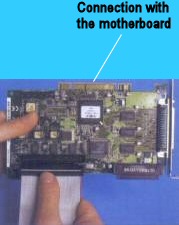FLAT RIBBON CABLES, IDE AND SCSI |
Flat ribbon cables enable transfer of data (bits) between mass storage devices and motherboard. It's good to know there are 2 types of disks and thefore 2 types of flat ribbon cables:IDE and SCSI disks.
IDE disks
IDE stands for Intelligent Drive Electronics or Integrated Drive Electronics. In order to achieve connection between mass storage devices and the processor there is need of a device (electronic circuit) called a controller which controls data transfers. With IDE that controller is integrated to the disk.
 Therefore the flat ribbon cable is connected straight to the motherboard on
one side and to one or two mass storage devices on the other side. There is
no controller between the two like with SCSI.
Therefore the flat ribbon cable is connected straight to the motherboard on
one side and to one or two mass storage devices on the other side. There is
no controller between the two like with SCSI.
These flat ribbon cables have usually 40 wires. That means bits and other control informations are carried through 40 parallel channels.
SCSI disks
It's usually pronounced "scouzi". It comes from "Small Computer Systems Interface". In this case there is an external controller between disks and motherboard but this system is much faster (and more expensive...).
 That
SCSI controller is an extension card plugged into the motherboard. SCSI flat
ribbon cables link that controller to the SCSI mass storage devices. There
can be SCSI hard disks and SCSI CD-ROM drives. On the photograph one can see
the connection to a SCSI controller.
That
SCSI controller is an extension card plugged into the motherboard. SCSI flat
ribbon cables link that controller to the SCSI mass storage devices. There
can be SCSI hard disks and SCSI CD-ROM drives. On the photograph one can see
the connection to a SCSI controller.
SCSI flat ribbon cables have usually 50 or 68 wires according to the model.
One can connect up to 16 peripherals with only one flat ribbon cable and one controller whereas in the case of IDE one can only connect 2 disks per flat ribbon cable.
| |
|
| Copyright 2003-2004 Jacques Lederer |
